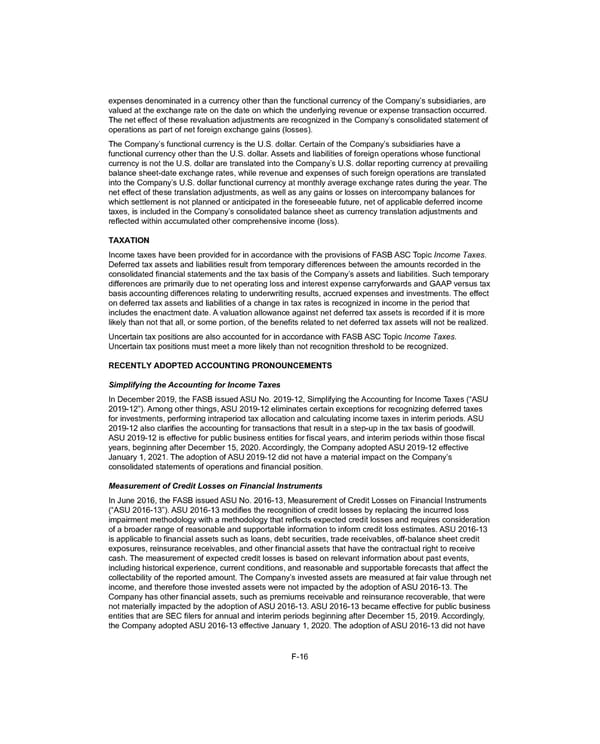expenses denominated in a currency other than the functional currency of the CompanyUs subsidiaries, are valued at the exchange rate on the date on which the underlying revenue or expense transaction occurred. The net effect of these revaluation ad>ustments are recognized in the CompanyUs consolidated statement of operations as part of net foreign exchange gains (losses). The CompanyUs functional currency is the U.S. dollar. Certain of the CompanyUs subsidiaries have a functional currency other than the U.S. dollar. Assets and liabilities of foreign operations whose functional currency is not the U.S. dollar are translated into the CompanyUs U.S. dollar reporting currency at prevailing balance sheet-date exchange rates, while revenue and expenses of such foreign operations are translated into the CompanyUs U.S. dollar functional currency at monthly average exchange rates during the year. The net effect of these translation ad>ustments, as well as any gains or losses on intercompany balances for which settlement is not planned or anticipated in the foreseeable future, net of applicable deferred income taxes, is included in the CompanyUs consolidated balance sheet as currency translation ad>ustments and reflected within accumulated other comprehensive income (loss). TAXATION Income taxes have been provided for in accordance with the provisions of FAS ASC Topic Income Taxes . Deferred tax assets and liabilities result from temporary differences between the amounts recorded in the consolidated financial statements and the tax basis of the CompanyUs assets and liabilities. Such temporary differences are primarily due to net operating loss and interest expense carryforwards and !AAP versus tax basis accounting differences relating to underwriting results, accrued expenses and investments. The effect on deferred tax assets and liabilities of a change in tax rates is recognized in income in the period that includes the enactment date. A valuation allowance against net deferred tax assets is recorded if it is more likely than not that all, or some portion, of the benefits related to net deferred tax assets will not be realized. Uncertain tax positions are also accounted for in accordance with FAS ASC Topic Income Taxes . Uncertain tax positions must meet a more likely than not recognition threshold to be recognized. RECENTLY ADOPTED ACCOUNTING PRONOUNCEMENTS Simplifying the Accounting for Income Taxes In December 2019, the FAS issued ASU No. 2019-12, Simplifying the Accounting for Income Taxes (“ASU 2019-12”). Among other things, ASU 2019-12 eliminates certain exceptions for recognizing deferred taxes for investments, performing intraperiod tax allocation and calculating income taxes in interim periods. ASU 2019-12 also clarifies the accounting for transactions that result in a step-up in the tax basis of goodwill. ASU 2019-12 is effective for public business entities for fiscal years, and interim periods within those fiscal years, beginning after December 15, 2020. Accordingly, the Company adopted ASU 2019-12 effective $anuary 1, 2021. The adoption of ASU 2019-12 did not have a material impact on the CompanyUs consolidated statements of operations and financial position. Measurement of Credit Losses on Financial Instruments In $une 2016, the FAS issued ASU No. 2016-13, 'easurement of Credit &osses on Financial Instruments (“ASU 2016-13”). ASU 2016-13 modifies the recognition of credit losses by replacing the incurred loss impairment methodology with a methodology that reflects expected credit losses and reEuires consideration of a broader range of reasonable and supportable information to inform credit loss estimates. ASU 2016-13 is applicable to financial assets such as loans, debt securities, trade receivables, off-balance sheet credit exposures, reinsurance receivables, and other financial assets that have the contractual right to receive cash. The measurement of expected credit losses is based on relevant information about past events, including historical experience, current conditions, and reasonable and supportable forecasts that affect the collectability of the reported amount. The CompanyUs invested assets are measured at fair value through net income, and therefore those invested assets were not impacted by the adoption of ASU 2016-13. The Company has other financial assets, such as premiums receivable and reinsurance recoverable, that were not materially impacted by the adoption of ASU 2016-13. ASU 2016-13 became effective for public business entities that are S C filers for annual and interim periods beginning after December 15, 2019. Accordingly, the Company adopted ASU 2016-13 effective $anuary 1, 2020. The adoption of ASU 2016-13 did not have F-16
 2021 Annual Report Page 158 Page 160
2021 Annual Report Page 158 Page 160